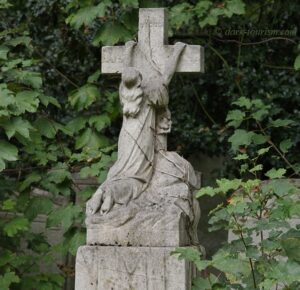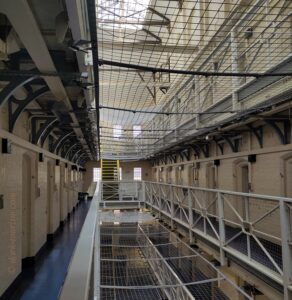On this day, 35 years ago, in the early hours of 26 April 1986, the Chernobyl disaster began. The story of that disaster, the technical details and the people involved, all that has been recounted numerous times in various places, including on my website (see Chernobyl, and ChNPP), and more recently this book (my review). For this post I decided to instead give you a photo essay and tell my personal story in relation to Chernobyl, gathered over the three tours to the Zone that I have to date been on. It features some of my favourite Chernobyl photos of my own. It is such an immensely photogenic place. But let’s start at the beginning:
I’m old enough to remember vividly the news of the disaster, which dominated all TV channels for weeks (a bit like it was after 9/11 too). I remember how politicians from the German Green Party seized the moment. Of course they were in a “told you so” position seeing their grimmest predictions vindicated. Even more vividly, however, do I remember the images that became available from the actual site. It looked like a disaster movie but was for real. And even far away at home in Hamburg it had an impact. We learned new units of physics, like becquerels, with which the radiation in contaminated food stuffs was being measured. Children were not allowed to play outside, especially when it rained. Wild mushrooms and venison were off the menu, even things like milk at dairy farms had to be poured away because of too high levels of radionuclides.
Twenty years later my then not-quite-yet wife found out that there were tours to Chernobyl, we then watched a short documentary about such a tour, and were instantly fascinated and keen to go ourselves. So, shortly after our wedding in late September 2006, we arranged a day tour from Kiev – where we spent a short break, as our immediate honeymoon. That’s why we can say, in slightly exaggerated form: we spent our honeymoon in Chernobyl! That has certainly raised some eyebrows on numerous occasions subsequently. (Btw. we also went on a “proper”, longer honeymoon, namely in Sri Lanka, after Christmas that year.)
Our Chernobyl tour was one of the short ones that have in the meantime become rather standardized. However, back then Chernobyl tourism was still in its infancy and so our group consisted of just six people – us, a young German couple and an older British couple – and ours was the only tour of the day. Hence we never saw any other visitors. It was just us six, the driver and the guide who we were assigned to on arrival in the Exclusion Zone. We were given an introductory lecture and were shown a video, then we headed to Pripyat and the NPP.
At the latter I took the photo featured above, and repeated below, of the iconic old sarcophagus that was built over the ruined block 4 reactor that had exploded in 1986:
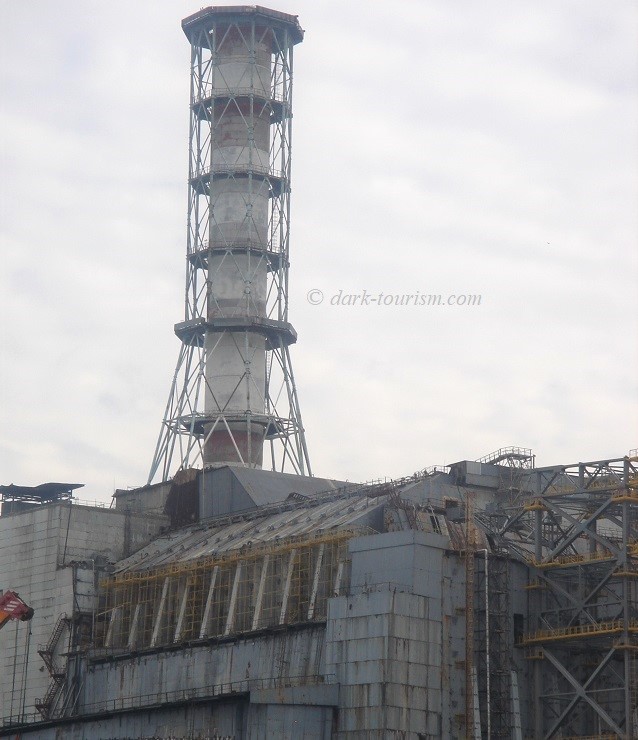
In the little logo on the top left of this page, the same featuring on my main website, you can make out the Chernobyl NPP’s chimney stack; I took that from precisely this photo. The real thing, however, is long gone. It was dismantled and replaced by a smaller ventilation stack further to the back, in preparation for the construction of the New Safe Confinement arch that was eventually moved over the old Sarcophagus. So this is a historic photo; a view that no longer exists. That also means, of course, that my logo is “outdated”, but for tradition’s sake I kept it as it is anyway.
Back to the 2006 tour. Before we went to the NPP we walked around a few parts of Pripyat, and took photos, such as this one (turned into black-and-white later):

The Cyrillic letters say “restaurant” and in the background you can see one of the tallest residential apartment blocks of Pripyat with a coat-of-arms symbol involving a hammer-and-sickle.
Another stop was at the funfair with the by now highly iconic rusty Ferris wheel standing tall amongst other, smaller-scale rides.

The van was our mode of transport and not a single other vehicle was to be seen in Pripyat, only in Chornobyl town and around the NPP did we pass others, mostly lorries.
When I learned years later that you can also do longer tours and even stay overnight within the Exclusion Zone, and thus have time to explore deeper and beyond the few standard points of interest, we were keen to return. It took us until May 2015 to finally do so. I had been recommended a guide so we had him arrange our private two-day tour. That obviously cost more than the standard day return tours, but we were confident that the extra investment would be worth it. And it so was! Our guide even made it possible for us to visit the inside of the NPP (now that’s nothing exceptional any more, but back then a special application was needed citing good reasons for wanting to go inside – but even though our stated reasons were made up we were still given the permit). Moreover, we saw lots of places we hadn’t seen in those few hours back in 2006, such as the harbour with its rusting wrecks, an abandoned riverside cafe, a fish farm laboratory, and the fabled Duga over-the-horizon radar array (but that’s visually so stunning that I will make a separate blog post about just that).
In Pripyat we did return to the iconic Ferris wheel and funfair, but this time we were also led inside various buildings. From a nearby sports centre I took this photo with the Ferris wheel inside a circular structure at some metal gate:

At the funfair we also got our first impression of what the standard day tours, now by big coaches, were evolving into. Suddenly we heard loud voices and shortly after a group of some 20 tourists arrived at the funfair, so it became suddenly very “busy”. That’s why we quickly departed and moved on. And the next thing we did was another highlight: we climbed to the roof of that tall apartment block with the Soviet symbol on it seen in the black-and-white photo above. Here is the view from the top:
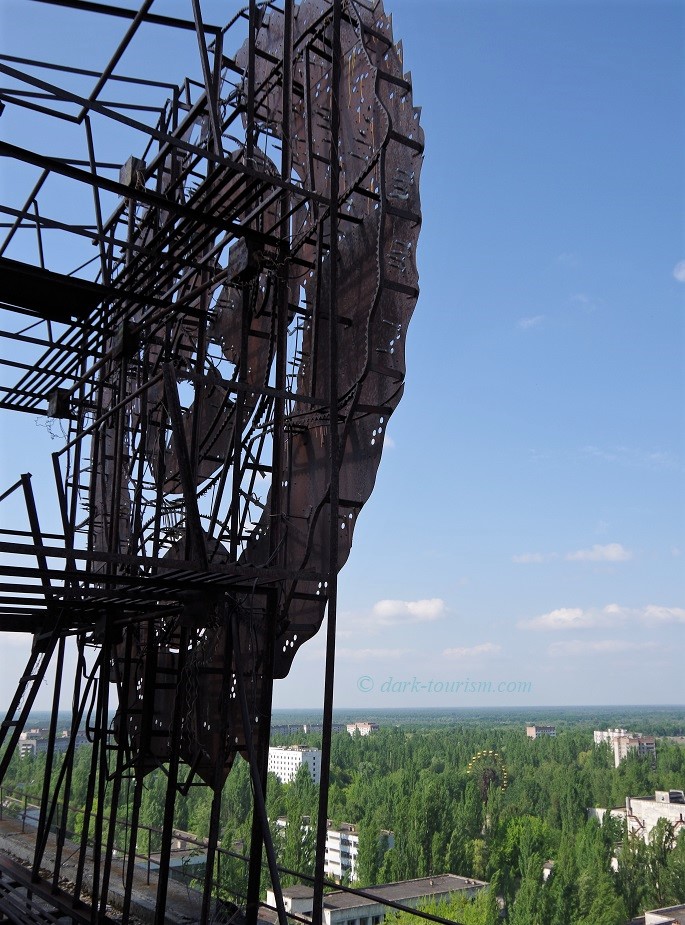
From up there we also got a good view of the NPP in the distance, with the New Safe Confinement structure under construction:

For getting up there we had to use the stairs, some 15 storeys up, but it was worth the exertion. The lifts obviously had long been dysfunctional but I took a photo down one of the empty lift shafts:

We also explored the insides of some apartments. Mostly these were empty but some appliances such as electric hobs or bathtubs were still in situ. Overall, though, the impression of vandalism and decay dominated. Here’s a shot of one of the ghost-town houses:
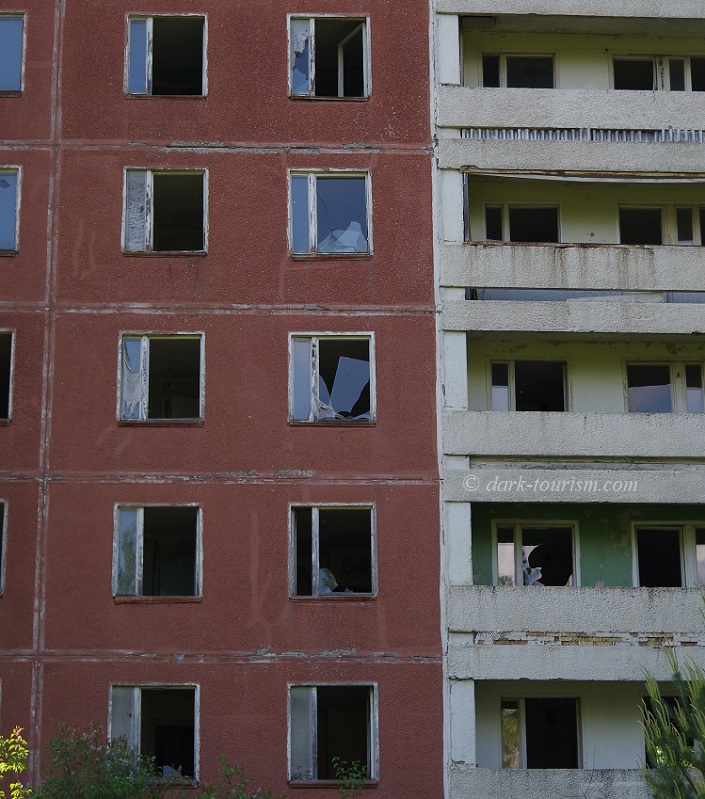
At one point we turned a corner and came to a building that had recently collapsed, in part at least, namely a former school. Where the walls have disappeared allowing a view in, you can make out some school furniture, a blackboard and a poster of Friedrich Engels:
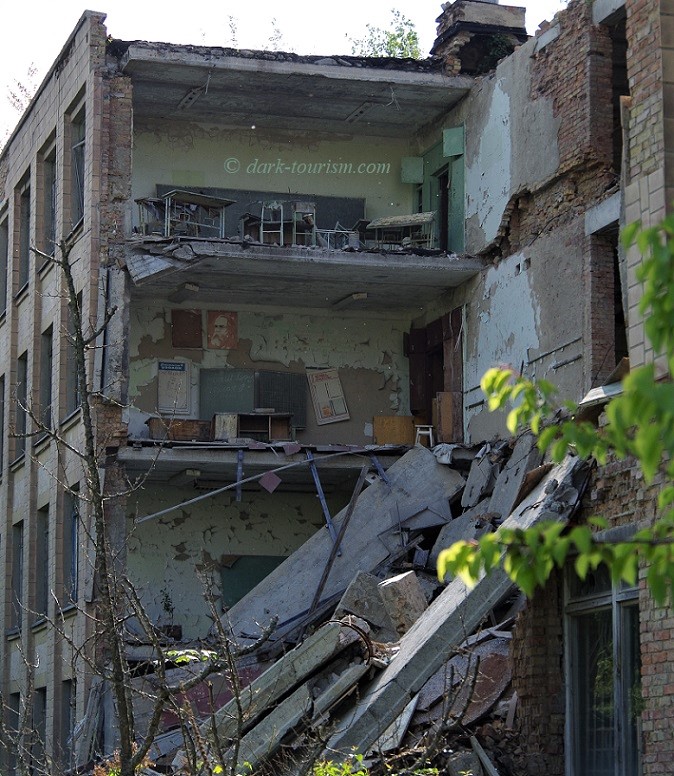
Because of this collapse, there was nominally a rule that prohibited people from going inside any buildings in Pripyat. But back then that wasn’t yet much policed, so we did enter various buildings, including another school, where I took this photo:
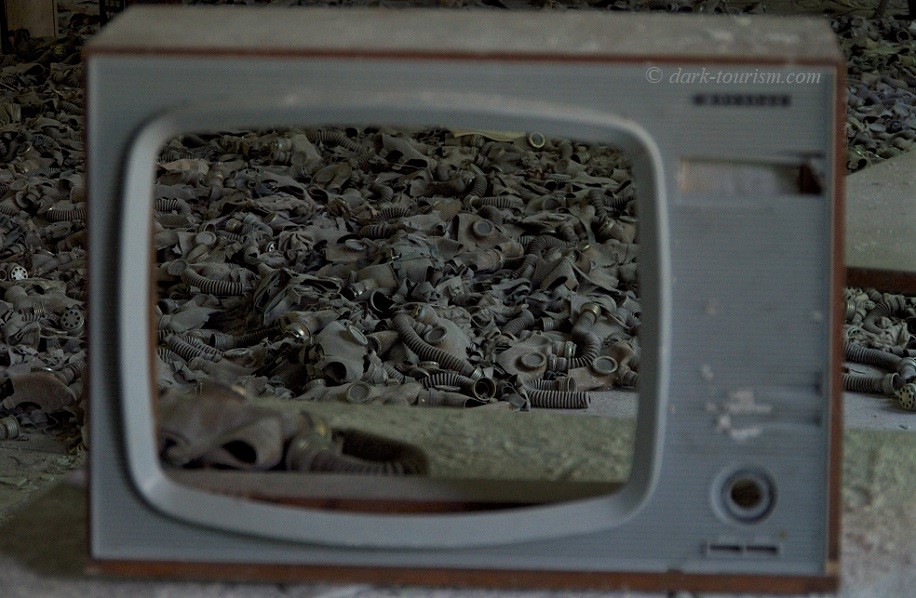
The mass of gas masks strewn all over the floor came from a depot of gas masks inside the school that some earlier visitors decided to scatter around. Some later visitors even went as far as making discarded dolls wear gas masks. All these are the sort of “manipulation” that some authors criticize as interference and unauthentic. Sure, there’s nothing authentic about gas-mask-wearing dolls, but it does make for an eerie sight. But I won’t go down that route here. Instead I give you another kind of image open to interpretation:

This is just the end of some rusty pipe that was lying around outside, but I thought the two small holes looked like eyes and the big one thus like a wide-open mouth, as if the pipe is screaming or saying “wow!”.
Another highlight of that 2015 visit was going to the unfinished cooling towers intended for the equally unfinished reactor blocks 5 and 6. Here’s the taller one of those cooling towers:
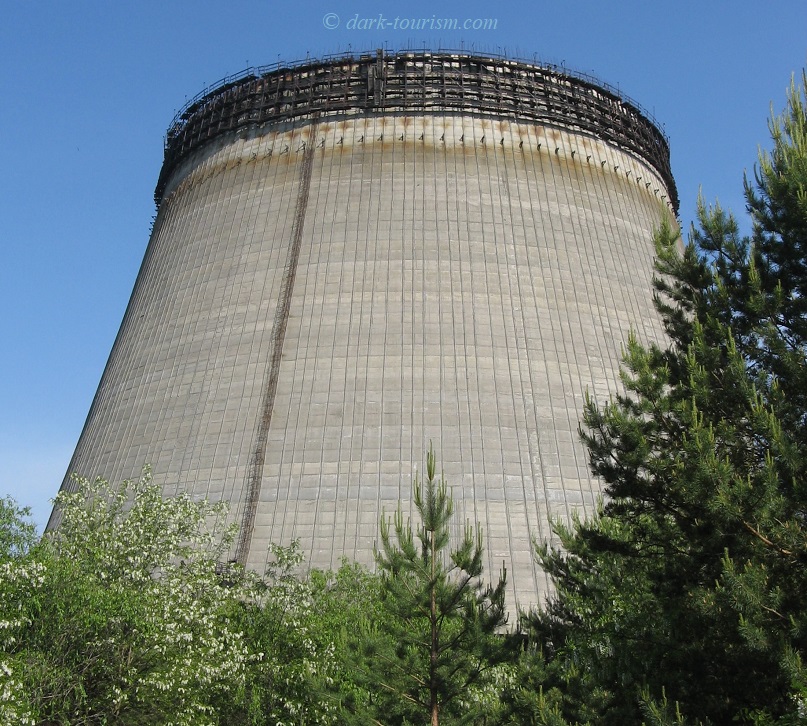
We also went inside the cooling tower, which is an immense space, so that was quite something to behold. Looking up you can see the scaffolding structures at the top. And because some of these had already come off and fallen down, we mostly stood more in the centre than directly underneath the crumbling scaffolding:
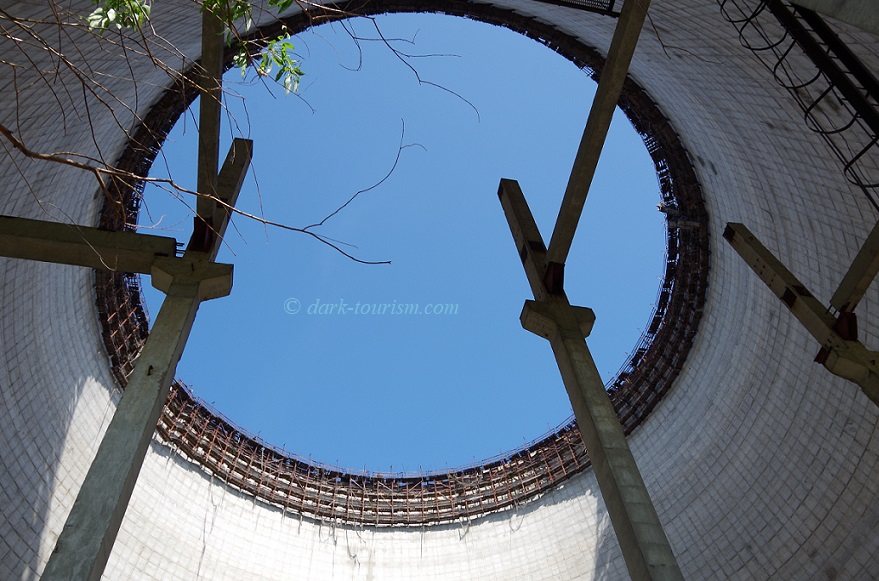
We were not alone inside the cooling tower. Circling along the top were two birds of prey, projecting their shadows onto the inside of the cooling tower’s wall:
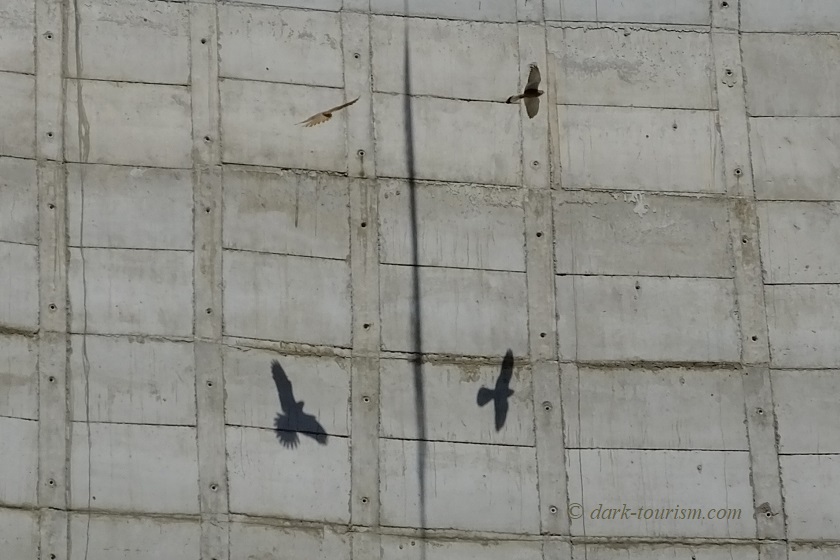
The top highlight, of course, was going to the NPP, and even getting to see it from the inside. But we also went to the construction site of the New Safe Confinement arch – which was about three-quarters finished at the time, and already an absolutely massive sight:
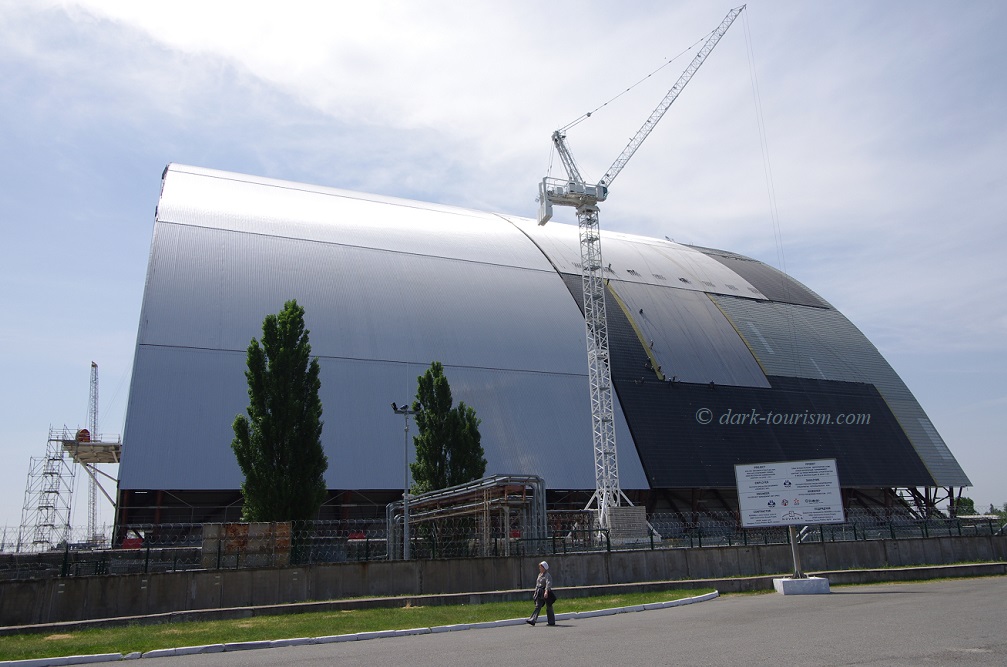
Inside the plant we first had to register and put on overshoes and white lab coats and hats. Then a guide from the ChNPP company led us into the so-called Golden Corridor. This runs the length of the building, hundreds of metres, linking all four blocks of the plant. The metal cladding is apparently part of the radiation shielding efforts.

The most impressive bit was being allowed inside one of the control rooms, in our case that of Block 2, which was partly still in use, for monitoring the decommissioning of the plant. So three NPP staff were in there staring at monitors while we were allowed to take lots of photos. One of the best I managed to take, I think, is this one:

I had never taken so many photos within the space of just two days as on that 2015 Chernobyl trip, and with several cameras with different lenses. And even though we had seen a lot on this trip, and learned a great deal from our superb guide, we sensed that we had far from exhausted the Zone. I still had a growing wish list of further places to visit one day.
It so happened that a couple of years later I was contacted by a journalist who wanted to do a piece about me and dark tourism for the reputable German news magazine DER SPIEGEL. He wanted to accompany me on one of my dark-tourism trips, and so we ended up deciding on Chernobyl and arranged another two-day trip with that same excellent guide. A pro photographer came along too, so we were a small group of four.
We went in November 2018, and when we arrived, by train from Slavutych (the town that was built outside the Zone to replace Pripyat), winter set in with heavy snowfall, which enhanced the atmospheric ghost-town effects as you can see in the next few images. This first one is actually the last photo I took on that trip, at dusk on teh second day, namely at the viewpoint of block 4 with the memorial monument that was erected there sometime after my first visit in 2006. And in the background you can see the New Safe Confinement structure in place over the old block 4 sarcophagus:
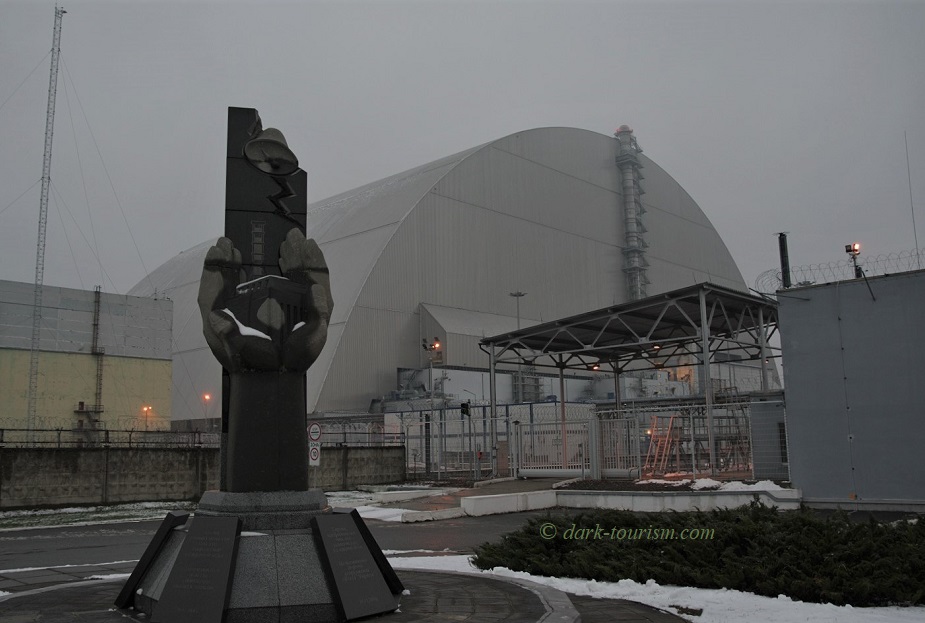
We started our touring from the ChNPP train station early in the morning, dropped our luggage off at the guest house in Chornobyl town, and then headed straight to Pripyat. Again we paid the funfair a visit … which was very atmospheric with the snow. Since we got there so early, well before any regular tour groups would get to the Zone, we left the first footprints in the fresh snow, so it felt even more ghost-town-y and totally silent. Well, almost silent. One of the carousels, seen here in the centre, was slowly rotating in the wind and making eerie screeching noises as it turned, like it had a life of its own …

As we walked around Pripyat I suddenly spotted some ripe apples hanging off a tree, now crowned by new snow (obviously nobody picks these fruits, as it wouldn’t be a good idea to eat anything that grows in this location):

The snow even infiltrated the insides of buildings, like the light dusting on these pieces of furniture:

Again, even though we had to sign an official form that said entering any buildings was prohibited, we still went inside various places: the piano storage, some sports centre, and whatnot. Here’s a classic photo from the Pripyat music school:

We had a look around the post office for a while too, and on the ground floor there is a classic wall mural with Soviet symbolism and this somewhat flaking cosmonaut:

Again, we entered some schools, and in one classroom I took this picture:

Something that was new for me was the hospital and I was very happy to be led inside. It’s the very hospital where the firefighters were first taken who got severely (and in many cases lethally) irradiated in the initial response to the accident. Their clothing, boots and helmets are still stored in the basement, and that’s one of the most infamous hotspots in the Zone. Some visitors have entered that basement and, rather irresponsibly, even retrieved items from there. A helmet disappeared – goodness knows where it ended up. When we were there, only a bit of belt was lying by the stairs down to the basement. We didn’t go down there, and one should only do so with some form of protective over-clothes and a mask, but we explored the upper floors of the hospital. I always find abandoned hospitals eerily fascinating, and here in Pripyat it was extra atmospheric. I took loads of photos, but I think my favourite shot of them all is this one from the maternity ward:

Another top highlight was visiting a place that is nominally even more out of bounds than any interiors in Pripyat: the unfinished reactor block 5, seen here with the construction cranes atmospherically reflected in the water that has accumulated in the foundations of what would have become a turbine hall:

We sneaked inside and up the stairs to reach the roof of the reactor block, from where we got a good view of the NPP in the mist as well as down to the collapsed crane:
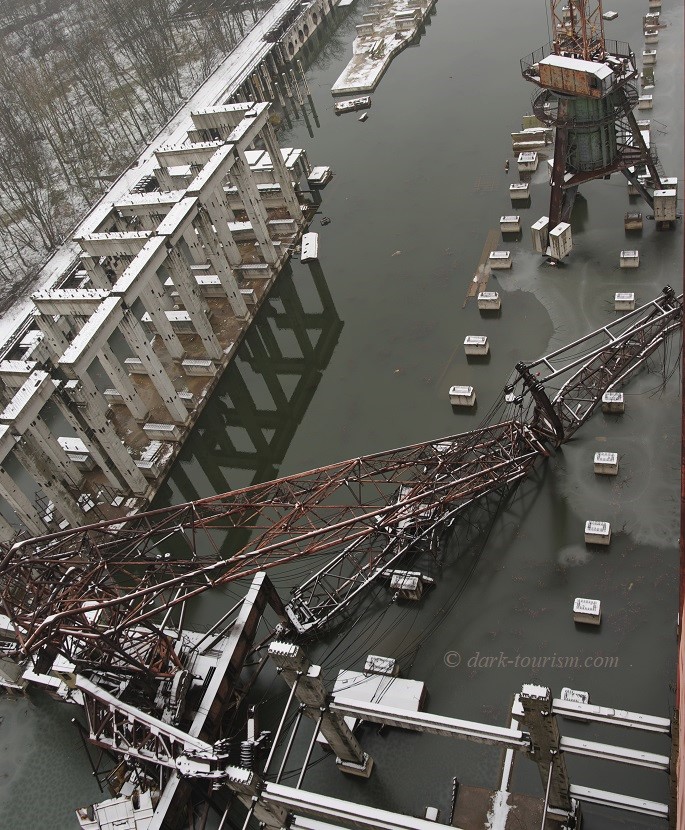
We also explored parts of the interior of the reactor block, including the space for the so-called biological shield into which the reactor core would have been inserted had the block been finished. Next to this were the would-be cooling water pump halls. The big holes in the ground, where the pumps would have been installed, made for veritable pitfalls:
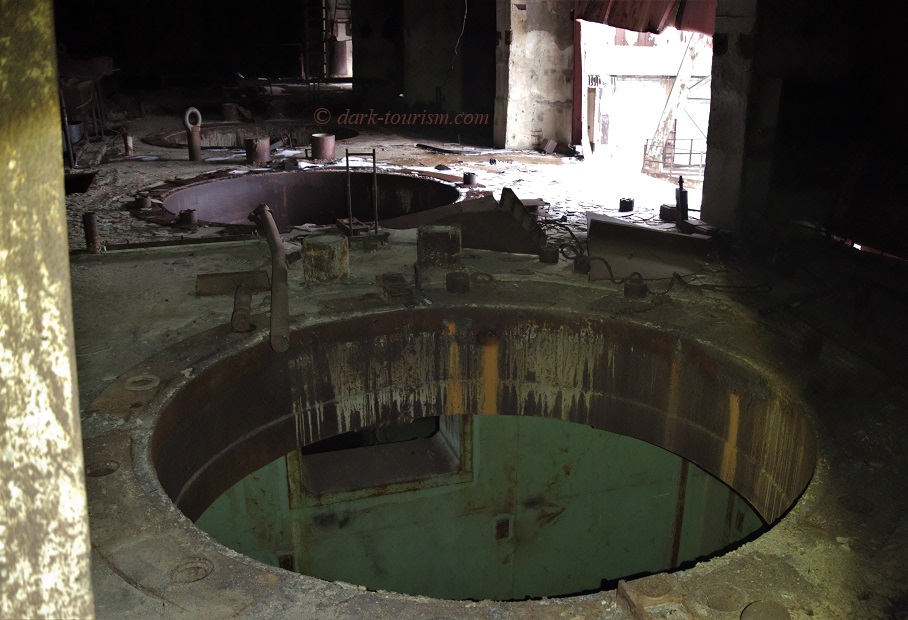
Away from any opening it was pitch-black inside the reactor building, so I was glad I had invested in a good-quality, hi-lumen LED torch before the trip. This also came in handy when on the first evening, we went inside the Pripyat police station as it was already getting dark. Here’s one of the holding cells at that police station, illuminated by my torch that my fellow photographer was holding for me. Makes for yet another atmospheric photo:

Occasionally you can spot things that are almost accidentally funny, like this sign at the old Jupiter factory on the edge of Pripyat:

“Remont” is a Russian word meaning as much as ‘not operational’ or ‘under refurbishment’, and the words above mean “do not switch on” … yet there’s nothing left to switch on anyway, as all electrical equipment that may once have been inside this cabinet had long been looted.
This blog post has featured a solid 30 photos, more than any other post before on this DT Blog. But Chernobyl is a worthy location to be featured that way. It’s one of the top dark-tourism attractions in the whole world, and I find it more photogenic than any other place I am aware of.
As announced above, I’ll also give you a separate post soon that features yet more photos, namely ones taken at the stunning Duga radar.
But for this post I shall come to a close now. I hope you’ve enjoyed it.


